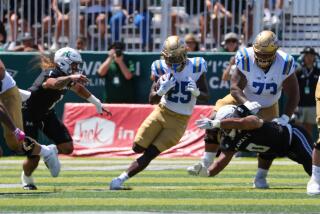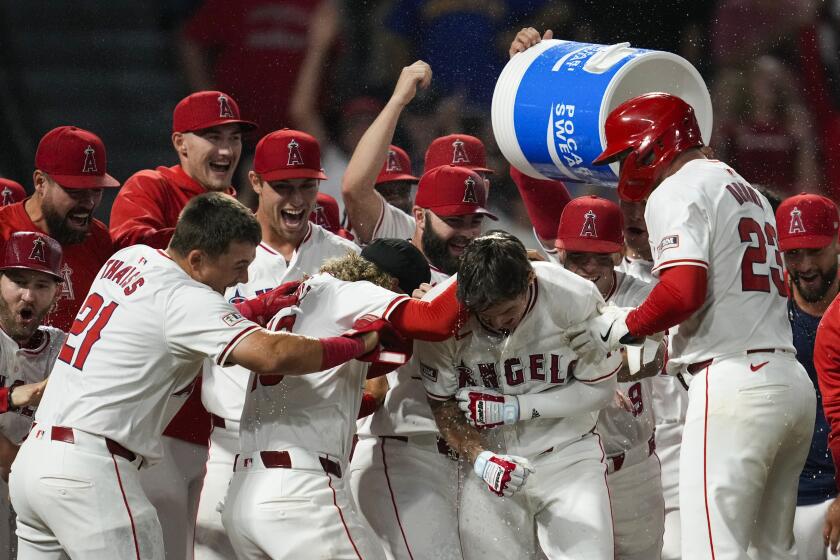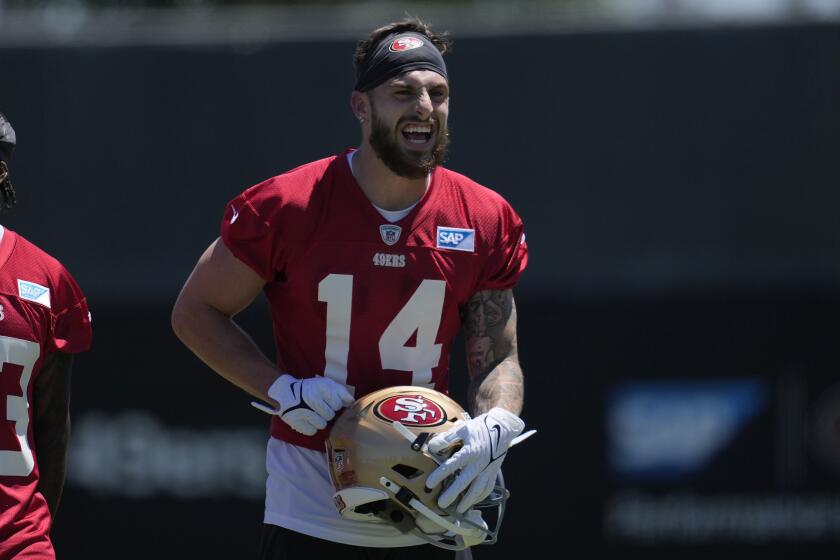Groff’s Grand Beginnings : Impressive Debut in Indianapolis 500 Ends Abruptly After 68 Laps
The next time you’re cruising the Ventura Freeway in light traffic--from 3 to 3:15 a.m. on a Wednesday might be your only shot at this--and you pull alongside a cream-colored 1955 Porsche Speedster, get any ideas of racing out of your mind--the car might be driven by Mike Groff, and you don’t want to race against him.
Not, of course, unless you have also had the experience of going wheel to wheel with Rick Mears and A. J. Foyt at 220 m.p.h. in the Indianapolis 500 and did not flinch.
Groff, 29, made his Indy debut last month and set the speed record for a rookie in qualifying with a blistering lap of 219.015 m.p.h. in his Lola-Cosworth. He started the race in the 18th position on the grid and within 50 laps had hammered the car into the top 10, where he spent more than a dozen laps running nose to nose with Arie Luyendyk, the 1990 Indy 500 winner and the third-place finisher this year.
And then, a $50 engine part could stand the strain no longer and, in a flash, Groff was out of the biggest race of his life after 68 laps.
For Groff, who grew up in Northridge and now lives in Studio City, it was not the end of the world. It might, as a matter of fact, have just been the beginning of the glory.
Groff’s racing career began on a tiny motorbike at the age of 8. The race track on which he competed against his brother Robbie and sister Debbie was the sprawling yard in Northridge of his grandfather. Among the obstacles were the usual things. Trees, shrubs. The house. Among the unusual obstacles were farm animals. Chickens and such.
“Even then, I was hooked on racing,” Groff said. “I remember the excitement, the thrill, of racing those motorbikes. It wasn’t that much different than the feeling I get now racing Indy cars. The same rush of adrenaline.”
From those feather-raising beginnings, Groff moved into the smallest race cars in the world, 15-horsepower bugs called quarter midgets on the smallest tracks in the world, in 1971. He was 10. With no chickens to dodge, racing was easy. Groff won 200 of about 250 quarter midget races over the next eight years.
He jumped into the slightly larger and more powerful go-karts for the next two years and competed on weekends. He won 20 of 30 races. At age 20, he took a big jump into midget cars, fast and powerful (albeit ugly) dirt-racing machines, and took rookie-of-the-year honors at now-defunct Ascot Park in Gardena, then one of the top midget tracks in the country.
The next year brought a move to the United States Auto Club midget circuit, and also a few rides in Formula Ford road racing, in which he produced two victories.
Oh. And that year, 1984, was also the year he broke his back.
“It wasn’t much, really,” Groff said. “Had a crash and broke my back. But within a few weeks, I felt OK.”
He raced again the same year. In a sport in which the participants consider anything less severe than amputation to be just a scratch, a race car driver was born.
Now fully into road racing, 1985 brought Groff to the Super Vee circuit, driving for the first time real race cars, Formula cars that looked much like Indy cars and produced 200 horsepower, capable of hitting speeds of 160 m.p.h.
Groff was on his way to Indy.
“I really began to think seriously about Indianapolis at the age of 18, racing midgets,” he said. “Midget racing was the way so many of the great drivers started, from A.J. Foyt and Rick Mears, and I wanted to follow the same path. But the Super Vees is where racing really started.”
In 1985 he was named rookie of the year in the Bosch/VW Super Vee Series, winning twice in 12 races and consistently finishing among the leaders. He won in Milwaukee and Phoenix in 1986 and also posted two wins on the American Racing Series. He finished the season second in the Super Vee standings and third in the ARS series.
“That year I knew I was on the right track,” he said. “I knew I had the potential to race the Indy cars.”
Now all he needed was a bit more money. Until then his career had been sponsored by his father Howard, owner of Northridge Equipment Rentals. Hundreds of thousands of dollars already had been spent, but to compete on the American Racing Series circuit full time, well, help was needed. Little was found.
“We got a few people interested, but when you’re racing at this level, people aren’t pounding on your door saying, ‘Here’s money. Take what you need,’ ” Groff said. “We struggled.”
Despite the struggles, there was continued success. In 1987, Groff won a big race at Nazareth, Pa., had six top-10 finishes in the 10 races and finished second in Toronto. But he crashed again. The wreck at Laguna Seca in Northern California came when his brakes failed and he piled the car head-on into a concrete retaining barrier. He was knocked unconscious but was not seriously injured.
“As demented and twisted as this sounds, that crash made me more determined than ever to race,” Groff said.
In 1989, he became the ARS national champion, dominating the circuit by winning four of the 10 races and finishing second in two others.
Then came his big break, his shot at the big time.
He met Antonio Ferrari, who was just getting his racing program, Euromotorsport, off the ground. Ferrari let Groff test drive his 1988 Lola Indy car and liked what he saw.
“From that moment, I was an Indy-car driver,” Groff said. “It was a big thrill.”
The thrill died quickly in May, 1990, when he tried and failed to qualify for the Indy 500. He did race, however. His first Indy-car performance came in the Detroit Grand Prix and he raced nine more times last year. He finished second in the rookie-of-the-year point standings.
The team bought a new car early this year, a 1991 Lola-Cosworth. It cost $300,000 as a “roller,” which is racing jargon for a car with no engine. The engine cost $70,000.
The car and Groff went back to Indianapolis.
“The first day we ran it, almost cold, we got in a lap of 214 miles an hour,” Groff said. “Right away, we knew we were there. We had the car.”
Unfortunately, they didn’t have a perfect water line to the engine.
After qualifying on the second day with that quickest-ever rookie lap, the Indy 500 was upon him. After barely missing disaster on the first lap of the race when a car driven by Buddy Lazier got sideways ahead of him, Groff settled into a comfortable race--if you can call thundering around a race track at speeds sometimes reaching 250 m.p.h. comfortable.
“I wanted to race conservatively,” Groff said. “I wanted to finish the race. That is a big accomplishment in itself.”
From 18th place, Groff began snaking his way through the field. To 15th place. And 12th. And 10th. And as high as seventh place where he encountered Luyendyk, the 1990 winner, and began to think about just how high he might finish.
Then the $50 aluminum water pipe ruptured, the car overheated in a matter of seconds and the day was over for Groff after 68 laps. In a field of 33 cars, he finished 24th.
“We spent a week rebuilding the car and went over every single piece of the engine,” Groff said. “Somehow, we missed that pipe. And it came back and bit us. When it broke in the race, I’ve never had that much emotion drain out of me. You’re so high, so pumped about the race and, in an instant, it’s over.
“But when everything is said and done, it was a dream to race in the Indy 500. I remember as a kid, 8 or 9 years old, telling everybody that someday I was going to race in the Indy 500. A lot of kids say that, I imagine. Just like they say they’ll play in the World Series. But I did it. My dream already came true.”
Groff raced last Sunday in the Detroit Grand Prix, once again falling victim to mechanical problems and completing just 26 of the race’s 62 laps. But he is committed to the rest of the Indy-car series this season, and next year, he vows to return to Indy.
“I’ll be better than ever,” he said.
More to Read
Go beyond the scoreboard
Get the latest on L.A.'s teams in the daily Sports Report newsletter.
You may occasionally receive promotional content from the Los Angeles Times.






